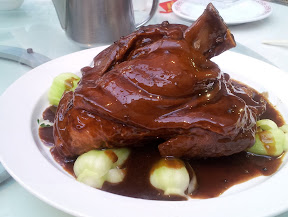While making a run at Portland U Brew in order to get some supplies for brewing a summer beer, I figured that while I had a car rented for the day and we were already on SE Milwaukie, how about having lunch in the area as well? My sisters just went to Thailand for a short stay and a visit to the rest of my family on both sides (my immediate family is in the US, but extended fam is all in Thailand, divided among Bangkok in central Thailand, Chiang Mai with their Northern cuisine, and my dad’s hometown of Nakhon Ratchasima also known as Korat in the Northeast). Thinking of them, I also have had lots of Thai food on my mind as I think about the deliciousness they are enjoying, as it’s been so long (since 2008) since my last experience in Thailand.
I haven’t actually eaten a lot of Thai food here in PDX because F often eats Thai already from the food carts during his workday, so having Thai for dinner or on the weekends isn’t the first thing we think of, and I should correct that. So far, of the Thai I’ve had, my experiences at Pok Pok, my visit to the food cart Nong’s Khao Man Gai for the Khao Man Gai specialty (and only) dish she offers, and E-San Thai where I loved their Nam Khao are standouts (and as I’ve written about before- click the links to read those entries). But I have quite the Thai To Do List- the wishlist includes PaaDee, Red Onion, Chiang Mai, Mee-Sen, Cha Ba Thai, and Manao, the latter of which is just down the street from P.U.B. Let’s see if I can work this list this summer.
Manao Thai was started by Ekkachai “Chef Chew” Sakkayasukkalawon, an alum from Andy Ricker’s empire including Pok Pok and Ping about a year and a half ago. Manao means lime by the way in Thai. Chef Chew has some staple Thai offerings, but also quite a few more unique Thai dishes that you won’t find as commonly on most Thai menus. Inside, you can tell this is a small family owned business who has kept the décor very minimal and functional.
We started with Manao’s Tao Huu Tod appetizer, a dish of fried tofu caramelized with sweet and sour sauce. A special on the board also listed Sai Ua, which is a Northern Thai sausage dish.
For mains, the vegetarian got the very passable Mussamun Curry with potato, carrot, onion and peanuts (here shown with tofu), I enjoyed both my dishes of the decent Kao Pad Kun Chiang, a dish of fried rice with egg, Chinese sausage, onion, tomato and Chinese broccoli, and then a more unique offering of Thai Chicken Wings, deep‐fried marinated chicken wings caramelized with sweet fish sauce. Are they as good as the Ike Vietnamese Chicken Wings at Pok Pok? Well, they are not as spicy, but still enjoyable and without the wait you would have otherwise had. This seems like a more casual, homey version that is more Thai than Vietnamese, and as noted is more sweet than spicy and good crispyness.
I was also excited to see a Thai dessert you don’t always see on menus here: Sweet Roti, an Indian‐style flat bread top with sweetened condensed milk and chocolate syrup. This is a very sweet dessert. But, I thought this was much better than what our usual stop would have been after P.U.B.- Dairy Queen!
I will probably be back again when we make another run to P.U.B., as there are other special Thai dishes that caught my eye, such as Kaa Muu Tod, a stewed pork leg dish stew with mustard greens; Kaeng hung lay, a funky Northern Thai pork shoulder curry; the labor intensive spicy Som Tum or papaya salad (get it with sticky rice) of which the mashing of the chilis gave Pok Pok its name; and Pad Wuun Sen Kai Kem dish with stir-fried salted duck egg with glass noodles and ground pork. There is a lot right in front of the restaurant for convenient parking. If you visit, please, take the opportunity to try out some dishes that are not the standard fare you will normally see. Make sure to check out the specials board too for more authentic flavors.












